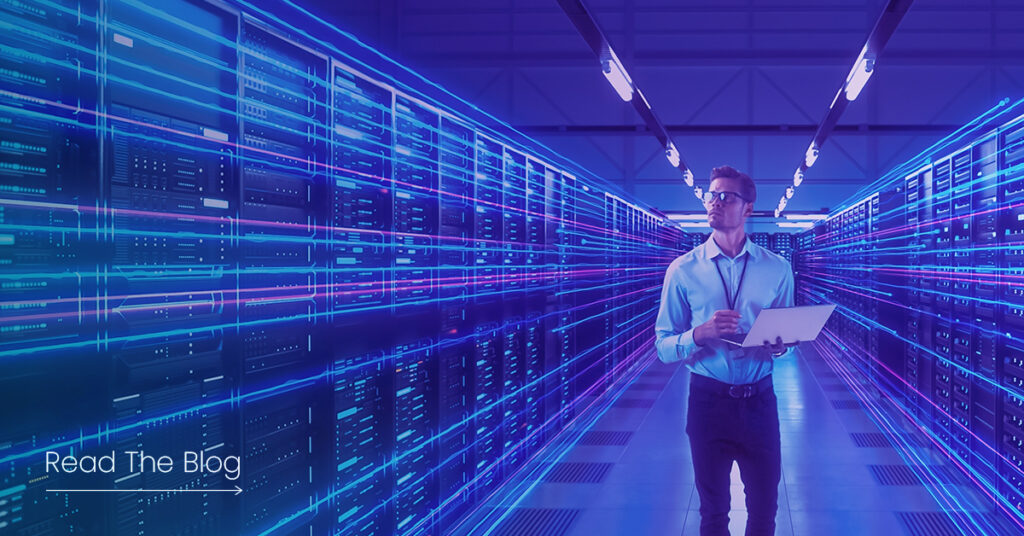What does a data center do?
Simply said, “a center for data,” a data center is a physical (or sometimes virtual) facility that houses computer systems and networking equipment. A Data center’s main job is to store and manage mass data. Data centers ensure uninterrupted access to essential IT services, including applications, data storage, and communications for businesses and individuals. Here’s what a data center does:
-
Keeps data in place:
Securely stores massive amounts of digital data, making it easily accessible for users and applications.
-
Processes Power:
Provides the computational infrastructure required to run applications, perform complex calculations, and analyze large datasets.
-
Maintains network connectivity:
Ensures seamless communication between devices, servers, and users by providing high-speed internet and networking capabilities.
-
Recovers data if needed:
Offers systems for data backup, replication, and recovery in case of hardware failure, data loss, or natural disasters.
-
Keeps data secure:
Implements robust physical and digital security measures to protect data from unauthorized access, cyberattacks, and breaches.
-
Helps businesses scale:
Allows businesses to scale their IT resources up or down based on demand, ensuring efficiency and cost-effectiveness.
-
Provides Compliance and Regulatory Support:
Helps businesses meet industry standards and government regulations for data storage and privacy.

What categorizes data centers?
Knowing the different types of data centers helps you better understand the work and importance of these centers. Data centers are often categorized by size, function and other factors. Here are some Classification criteria for data centers
Size and Capacity:
- Enterprise Data Centers: Large-scale facilities serving the needs of a single organization.
- Hyperscale Data Centers: Massive facilities used by tech giants (like Google, and Amazon) to support enormous data processing and cloud computing.
Ownership and Control:
- Colocation Data Centers: Rented spaces where multiple organizations share infrastructure but maintain their own equipment.
- Managed Data Centers: Managed by a third party, offering both infrastructure and IT management services to businesses.
- Enterprise-Owned Data Centers: Fully owned and operated by a single organization, providing exclusive control over the facility.
If you want to know about data center tiers come here.
Type of Facility:
- Cloud Data Centers: Primarily offer cloud computing services managed by third-party providers.
- Edge Data Centers: Smaller facilities located near users to provide low-latency services, commonly found in highly populated areas.
Workload and Function:
- Application-Specific Data Centers: Tailored for specific tasks, such as research computing or financial transaction processing.
Types of data center
Now that you know what data centers are and how they’re categorized, it’s time to get a better understanding of each of them. Here are the main four types of data centers that cover the broadest range of services, ownership models, and use cases. Many of the big global data centers, like Apple’s in Nevada and Google Cloud, are included in these types.
-
Enterprise Data Centers
These are called “enterprises” because they need to manage vast amounts of data for huge organizations. An Enterprise data center is built for the sole use of a single company and is, therefore, considered a private facility. This facility is custom-built for the company’s spatial needs and requirements and is usually located on-site or in an owned building to provide power and security.
Imagine “Bank Of America,” one of the largest financial institutions in the world. This bank handles enormous volumes of sensitive financial data, including customer transactions, personal information, and financial records. This data needs to be highly secured and calls for full control over the infrastructure. By operating their enterprise data centers, they ensure critical systems remain secure, compliant with financial regulations, and highly available to support uninterrupted banking operations.
-
Colocation Data Centers
Colocation or “Multi-tenant data centers” are facilities that host the data needs of other organizations and companies somewhere offsite. The provider/owner rents a colocation data center to the company. The provider will also manage the infrastructure (power, cooling, security, etc.). The data still belongs to the main company; it’s just being handled elsewhere, so the cost and complexity are manageable. This is popular among e-commerce, SaaS providers, and growing businesses.
An example is Netflix, which uses these facilities to store and deliver large amounts of video content to users worldwide. Instead of building its own data centers, Netflix rents space in colocation facilities, where it can install its own servers. This strategy allows Netflix to scale efficiently and deliver high-quality streaming services while the Multi-tenant provider ensures reliable power, cooling, and network connectivity.
-
Hyperscale Data Centers
Hyperscale Data Centers are massive facilities designed to support the large-scale computing and storage needs of companies with extensive digital operations. These data centers are built to handle large amounts of data and traffic, offering scalable infrastructure that can grow as demand increases. They typically host cloud computing, big data, and artificial intelligence services. The main users of hyperscale centers are ones that need enormous computing power and storage, such as cloud service providers, social media platforms, and tech giants.
Take Amazon Web Services (AWS), for example, which operates one of the largest Hyperscale data center networks in the world. AWS supports millions of customers globally, including governments, enterprises, and startups, providing cloud services like storage, computing, and machine learning.
-
Cloud Data Centers
While the term “cloud” may seem virtual, cloud data centers are very real physical facilities. The “cloud” aspect comes from how resources are delivered virtually over the internet. Cloud Data Centers are facilities that provide on-demand computing resources, such as storage, networking, and applications online. Instead of companies owning and maintaining their own infrastructure, they rent or lease cloud services from providers who manage the physical data centers. This allows for scalability, flexibility, and reduced capital costs, as businesses pay for what they use.
A well-known example is Spotify, the popular music streaming service. Spotify uses Google Cloud to manage its extensive data processing needs, such as music recommendations and playlist generation. By leveraging cloud infrastructure, Spotify can scale its services to meet global demand without the need to build and manage its own physical data centers.
-
Edge/ Micro Data Centers
These ones are small, localized data centers positioned closer to the end-users or devices they serve. They are designed to reduce latency and improve processing speeds for applications that require real-time data, such as IoT, gaming, autonomous vehicles, and smart cities. These centers bring computing resources physically closer to the source of data generation, allowing for faster data processing and reducing the load on larger centralized data centers. The users are companies that require low latency and real-time data processing.
A well-known example is Tesla, which uses edge data centers to support its autonomous vehicles. These data centers process vast amounts of data generated by sensors in Tesla cars in real-time, allowing for faster decision-making without relying on distant cloud data centers.
Related article: What Is a Micro Data Center?
How Do You Choose the Right Data Center?
Selecting the data center that fits your business requires knowledge of all the types, how they work, how they’re tailored to the company’s needs, and the level of security they provide. It’s best to start by assessing your workload requirements—whether you need a colocation, enterprise, cloud, or edge solution. Consider the location to ensure low-latency connections and compliance with local regulations.
Also, remember to evaluate the security measures in place, including both physical and cyber protection. Check the provider’s uptime guarantees, disaster recovery capabilities, and scalability options to handle future growth. Finally, review the cost structure to ensure it’s in line with your budget while providing the required flexibility and reliability for your operations.
Final Thoughts
These were the types of data centers in a nutshell in dana cloud. Based on size, workload and security level, there might be other kinds, too, but these were the main data centers used worldwide. As tech companies grow and scale, their needs change, and they might need to shift from one type of data center to another.
Having a perception of data centers and their duties will help you make the right decisions regarding the security and restoration of data, scaling your business more meaningfully.


